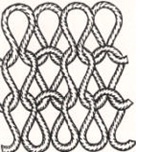Presented by: Rashedul al rashid
Email: .............
Fully Fashion Knitwear
Knit fabric Notation
Knit
fabric notation is the symbols which represent
different types of loops.
Like: For technical face loop (V
shape) indicate as T
And Technical back loop (semi circle shape) indicate as
Importance
of knit fabric notation:
Language differences and variation
in terminology cause communication problem for different trade personnel from
different country. Fabric description may vary even among organization within
the same country. The most visually accurate way of communication is to draw
full loop structure. But however accurate drawing is much more complicated and
time consuming. That’s why trade personnel prefer the notation.
|
Notation
of Single Jersey:
|
Notation
of Double Jersey:
|
Notation
of Rib (1×1):
|
||||||||||||||||||||||||||||||
|
|
|
Process Breakdown of Fully Fashioned
Knitwear
|
Body Panel (Front or Back):
|
|
N
|
|
Prepare
rib height
(as
per requirement)
B
|
|
Loop
transfer from back needle bed to front needle bed
(if
the body panel is in jersey)
B
|
|
K
|
|
Create
armhole
(depends
on styling)
By
decreasing or increasing, decreasing both.
|
|
Sleeve Panel:
|
|
N
|
|
Prepare
rib height
(as
per requirement)
B
|
|
Loop
transfer from back needle bed to front needle bed
(if
the sleeve panel is in jersey)
B
|
|
Knit
up to armhole line starts point
|
|
Linking:
|
|
L
|
|
A
|
|
L
|
|
A
|
|
S
|
|
End
of operation
|
Understanding different fancy stitches/ design:
|
Identification:
|
|||
|
Name
of Stitch
|
Construction
|
Appearance
|
|
|
Shaker stitch/ Half cardigan
stitch
|
:
|
Normally 1×1
|
T/F & T/B are not same. T/F
looks fluffy/ bulky & T/B looks tight V-shape/chain stitch
|
|
Full cardigan stitch
|
:
|
Normally 1×1
|
T/F & T/B are same. Both looks
raised V-shape.
|
|
Milano stitch
|
:
|
Normally Double jersey
|
T/F & T/B are not same. T/F joint
V-shape & T/B chain stitch.
|
|
Zigzag stitch
|
:
|
Any construction
|
Waleswise
|
|
Drop knit
|
:
|
Odd construction like: 5×1,
3×1,5×2,4×3 etc
|
Both side not same. Could be
double bedded or single bedded.
|
|
Pointal stitch
|
:
|
||
|
Tuck stitch/ Pineapple stitch
|
:
|
It covers (single or double side)
with tiny holes.
|
|
|
Cables
|
:
|
|
|
|
Diamond
|
:
|
|
|
Thanks and Best regards
Bipul


